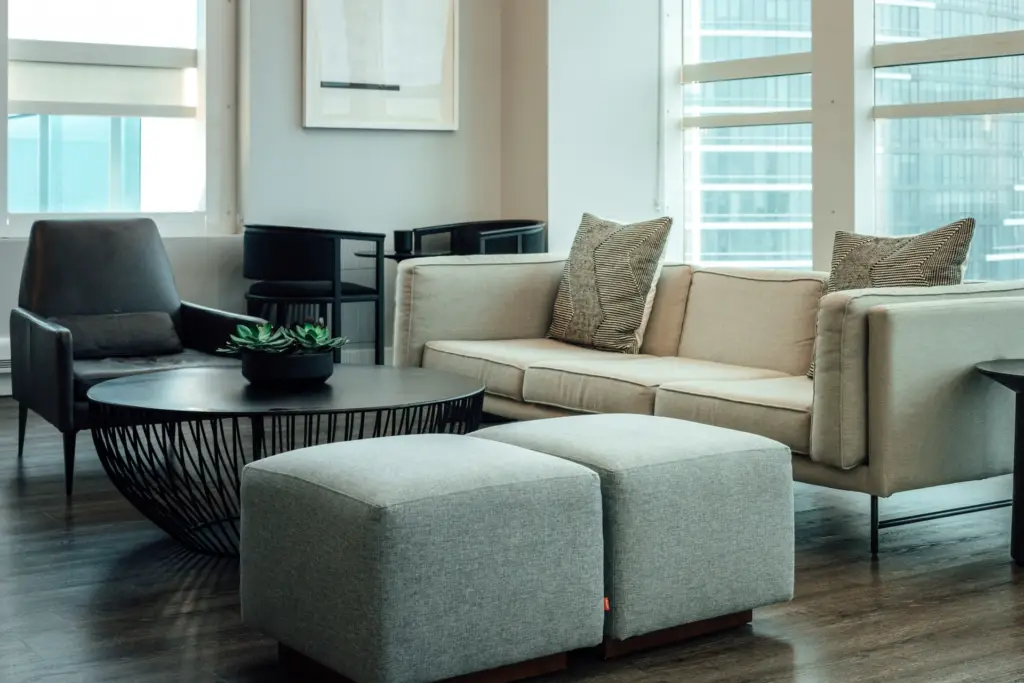Poufs and Ottomans serve broadly similar functions, and you’ll often find them in the same place in your local furniture shop. However, there are some crucial differences that set them apart from each other.
One of the most obvious differences is in the firmness. Where poufs are often soft and pillow like, Ottomans are firm like sofas and armchairs. Ottomans generally have solid frames and so have a more set structure and hardwearing feel. It’s also common to find Ottomans with legs, while poufs will often be designed to sit flat on the floor like a bean bag.
Both ottomans and poufs come in a range of materials and sizes and both offer extra, flexible seating for the living area. So, it really just comes down to which style you prefer and which option best suits your needs.

Modern and vintage poufs and ottomans
Poufs and Ottomans come in both modern and vintage designs. Modern poufs and Ottomans generally have crisp clean lines and minimal embellishment while vintage style furnishings often have a few more flourishes.
If your living space has a contemporary feel, a modern light grey or white piece will look great with your other furnishings. Large poufs and Ottomans can also have a more modern feel, however it’s important to measure your space before you buy oversized furnishings to ensure they’ll fit.
Alternatively, if you like a vintage feel, choose a pouf or Ottoman with a mid-century modern aesthetic. Ottomans generally have a slightly more retro feel than poufs. This is because their legs provide more opportunities for vintage design touches. Ottomans with wooden or metal legs can work really well with mid-century modern style sofas and armchairs. Choose an Ottoman in a similar style to your other pieces to create a fantastic, unified aesthetic or opt for one in a contrasting colour to bring a pop of visual interest to the space.
Finding the right legs
Most Ottomans have wood or metal legs supporting the main seating area. The legs have a quite a big impact on the overall look of the furnishing, so it’s important to choose a design you’re happy with.
Elegant brass legs often give pieces a vintage feel. Angled wooden legs also lend furnishings a mid-century modern aesthetic, especially when they’re made from a rich, dark timber.
If you want a more contemporary feel, choose an Ottoman with legs that go straight down or an Ottoman that has no visible legs at all. This will draw the eye away from the floor and focus attention on the upholstered part of the seat.
Upholstered poufs and Ottomans
Both poufs and Ottomans are upholstered in a range of fabrics including leather, boucle, polyester and acrylic. Leather is a good choice for retro interiors and homes with existing leather furnishings. However, it can be damaged by sharp claws and dander, so might not be the best choice for pet owners.
Fabric upholstery is perfect for busy family life and gives you a lot of flexibility when it comes to colour and finish. If you’re going for a light, bright Scandi-style feel, choose a pouf or Ottoman in a light grey finish. Or if you want to make a statement with your furniture, choose a teal, yellow or dark grey piece.
You can also find poufs and Ottomans in velvet. A fantastic choice for luxurious interiors, velvet is a great material for upholstery. If you know how to clean a velvet couch, you’ll easily be able to maintain your velvet Ottoman and ensure it looks good for as long as possible.
When choosing a colour and fabric for your pouf or Ottoman, look at the other textiles in your living space. Keeping the number of materials to a minimum can help an interior to look sleeker and more stylish, so try to stick with the same theme.
If this isn’t possible, you could tie your Ottoman or pouf into your interior design using scatter cushions. Choose cushions for your sofa that complement or match the colour of your Ottoman or pouf. If you’re not sure how to arrange pillows on a couch, experiment with a few different layouts to find your favourite look.
Outdoor Ottomans and poufs
Although most of us probably think of poufs and Ottomans as indoor furniture, there are some great outdoor options too. Outdoor poufs and ottomans can be used to create a comfortable and welcoming al fresco lounge and to make your garden seating area that bit more flexible.
If you do want to use an Ottoman or pouf outdoors, make sure it’s specifically designed for exterior use. These pieces will probably have treated wooden frames, removeable cushions and tough, hardwearing upholstery. Furnishings that are supposed to be used inside will be particularly vulnerable to the elements and may age a lot faster than they should if left outdoors.
Ottomans and poufs can be used as decorative stand-alone pieces, footstalls and extra seating. Perfect for living rooms, bedrooms and hallways, they’ll bring a little splash of colour and designer feel to your interior.










